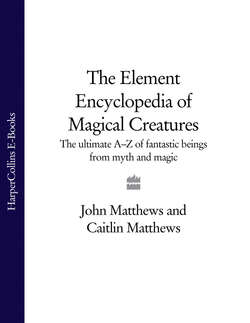Читать книгу The Element Encyclopedia of Magical Creatures: The Ultimate A–Z of Fantastic Beings from Myth and Magic - John Matthews - Страница 173
B BABA YAGA
ОглавлениеThroughout Russian and East European folk legend, Baba Yaga is famed as a hag who rides through the air in a mortar propelled by the pestle, or in a great iron kettle with her sweeping fiery broom. She lives in a moveable house which has chicken’s legs, in a forest clearing fenced by a palisade made of bones with skulls on top of them, from whose sockets spectral light is emitted. She has teeth of stone or knife-blades. Her mouth can become so huge that passing travellers may mistake it for a cave and so are drawn in and devoured. She is sometimes said to travel with Death and eats the souls of his victims.
Although Baba Yaga has become the archetypal bogey-woman with which to frighten children, she is actually a primal goddess whose knowledge of the world is unequalled. Baba Yaga can also appear as an old peasant woman of kindly disposition. To those who go to her for help, she lends her mirror, her ring, balls of yarn or a self-cutting sword – objects that enable heroes and heroines to achieve their quests. She is helpful to women and a guardian of good order and behaviour, punishing those who outrage it. Her broom shows that she cleanses and cleans, while her pestle and mortar are emblems of creation and destruction. In the earliest legends, she is the keeper of herds, horses and of farming, and is a primal divinity of life and death. In her hands are the reins of nature and its seasons. She controls the flow of milk from the cow, the fall of rain, the growth of crops and she can devour the sun or moon.
Baba Yaga confers upon Koshei, the dragon in human shape, his immortality. She also controls the fire-breathing dragon Chudo-Yudo, who guards the Water of Life and Death. Baba Yaga’s house sits between the world of everyday and the Otherworld, where it acts as a guardian to the land of the dead. The food that Baba Yaga brews in her cauldron is often made up of body parts, which makes a soup of new life to those who understand her true function, but which appears evil and repellent to those who fear her.
Despite her reputation for enticing and devouring human victims, Baba Yaga nevertheless recognizes good housekeeping and simple-hearted perseverance, as is seen from the story of Fair Vassilisa, a maiden who is sent by her stepmother to fetch light from Baba Yaga’s house, meaning for her to die there. Vassilisa serves Baba Yaga so faithfully that the hag gives her a lighted skull to take home; this horrid sight so terrifies the stepmother and her nasty daughter, that Vassilisa is left in possession of her parent’s house.
An elderly couple had a daughter but could not find a godmother for her. Baba Yaga, in the shape of an old woman, offered to be godmother and took the girl to live with her. When the girl offended her by breaking one of her rules, Baba Yaga exiled her to a dark forest alone. There a prince found the girl wandering. He married her and they had three sons who bore the moon and stars upon their foreheads. Baba Yaga demanded these three children in expiation of the girl’s crime, taking them and their mother away with her. The prince followed on and found them standing at the centre of a clearing, near a great fire, surrounded by animals. Baba Yaga allowed the prince to take his sons away but withheld her goddaughter to serve her.
